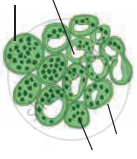Advertisements
Advertisements
Question
Identify the following diagram, label it and prepare a chart of characteristics.

Solution
Simple permanent tissue (parenchyma)-

- It is a type of simple permanent tissue.
- Cells in this tissue are thin walled, isodiametric, round, oval to polygonal or elongated in shape.
- Cell wall is composed of cellulose.
- Cells are living with prominent nucleus and cytoplasm with large vacuole.
- Parenchyma has distinct intercellular spaces. Sometimes, cells may show compact arrangement.
- The cytoplasm of adjacent cells is interconnected through plasmodesmata and thus forms a continuous tissue.
- This is less specialized permanent tissue.
- Occurrence:
These cells are distributed in all the parts of a plant body viz. epidermis, cortex, pericycle, pith, mesophyll cells, endosperm, xylem and phloem. - Functions:
These cells store food, water, help in gaseous exchange, increase buoyancy, perform photosynthesis and different functions in plant body. - Dedifferentiation in parenchyma cells develops vascular cambium and cork cambium at the time of secondary growth.
APPEARS IN
RELATED QUESTIONS
Answer the following question.
A fresh section was taken by a student but he was very disappointed because there were only a few green and most colourless cells. Teacher provided a pink colour solution. The section was immersed in this solution and when observed it was much clearer. What is magic?
Answer the following question.
While observing a section, many scattered vascular bundles could be seen. Teacher said, in spite of this large number the stem cannot grow in girth. Why?
Answer the following question.
A student was observing a slide with no label under a microscope. The section had some vascular bundles scattered in the ground tissue. It is a section of a monocot stem! He exclaimed. No! it is a section of fern rachis, said the teacher. Teacher told to observe vascular bundle again. Student agreed, Why?
Answer the following question.
Student while observing a slide of leaf section observed many stomata on the upper surface. He thought he has placed slide upside down. Teacher confirmed it is rightly placed. Explain.
Draw a neat labelled diagram.
T. S. of Dicot leaf
Draw a neat labelled diagram.
T. S. of dicot stem
Write the information related to the diagram given below.

Identify the following diagram, label it and prepare a chart of characteristics.

Identify the following diagram, label it and prepare a chart of characteristics.

Identify the following diagram, label it and prepare a chart of characteristics.

